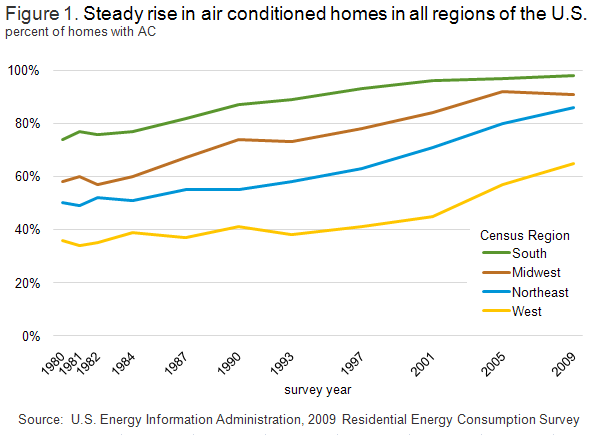HOW TO CHOOSE A HEATING AND COOLING SYSTEM: PART TWO
(Note: This is part one of a two part series and deals with choosing a heating system. Choosing an air conditioning system was discussed in July.)
The Basics
Here is how a basic overview of how most air conditioner works:
- A liquid refrigerant runs through metal coils.
- The refrigerant in the metal coils draws in heat from the surrounding air, turning into a gas.
- The warmed gas refrigerant goes to the compressor, which uses pressure to turn in back into a gas. This process releases heat, which leaves to the exterior air.
- Repeat steps 1-3.
Need
Depending on the location of your home or what you are using for, you may or may not want to install some form of air conditioning. In general, the cooler the climate in your location, the fewer number of days per year will require air conditioning. Air conditioning prevalence varies greatly by region. In the northernmost reaches and high elevations area of the United States, air conditioning may not be required at all. In the south, where summers are especially hot and humid powerful reliable air conditioning is a must. The following graph, from the U.S. Energy Information Administration, shows the percentage of homes that have air conditioning in each part of the country:

Think about what you are using the structure for as well. If you will be living in it full time, you may need to prepare for extreme weather. If, on the other hand, your dwelling is seasonal and won’t be occupied during hot times, it may not make sense to put in air conditioning.
Efficiency
There usual efficiency rating for air conditioners is called SEER (Seasonal Energy Efficiency Ratio). This number shows an estimation of the annual efficiency of a system. The actual number is the ratio fo cooling provided by a unit to the amount of every consumed. The higher the number, the more efficienct the air conditioning. In the United States, new systems produced today must have a SEER rating of higher than 13. Above 16 is generally considered excellent. The highest ranking is currently 25.
An air conditioners SEER rating should be listed near the top of the unit’s manufacturer label, which also contains information like the model and serial number. A model number that begins with 14AC, for example, denotes an A/C unit with a SEER rating of 14. Higher efficiency systems are more expensive, so it doesn’t necessarily make sense to just buy the highest one you can find. As always, you want to match your purchase to your situation. If you live in Phoenix, a high efficiency system may save you a lot of money in the long run. If you live in northern Minnesota or otherwise won’t be running your system often, it might make sense to buy a less expensive system.
Type
Central or whole-house air conditioning is the most powerful and provides the best cooling. Houses in the south are mostly likely to have central air. In northern and cooler areas, cheaper portable window can be placed for cooling only when and where it is necessary. In hot but dry areas like the American Southwest people often use an evaporative cooler, often called a “swamp cooler.” These work by cooling outdoor air with evaporating water, then pushing that air into the home and pushing warm air out open windows. Many areas in between can use a ductless mini-split system, which utilizes one or several units inside the home and doesn’t require any ductwork. These are becoming more popular as they gain efficiency.
Capacity
An undersized air conditioning will fail to keep your home cool. An oversized one is more than just wasted money. If an air conditioner is too powerful it works too quickly and does not remove sufficient moisture from the air. This can make you feel clammy and can contribute to mold and other damage. A correctly sized air conditioning system will dehumidify the air in your home, allowing you to feel comfortable at a higher temperature.
There are rules of thumb regarding square footage, but to really understand what the proper size system is you will want to have someone do a load calculation. Your installer should be willing to do this and
show you the results.

